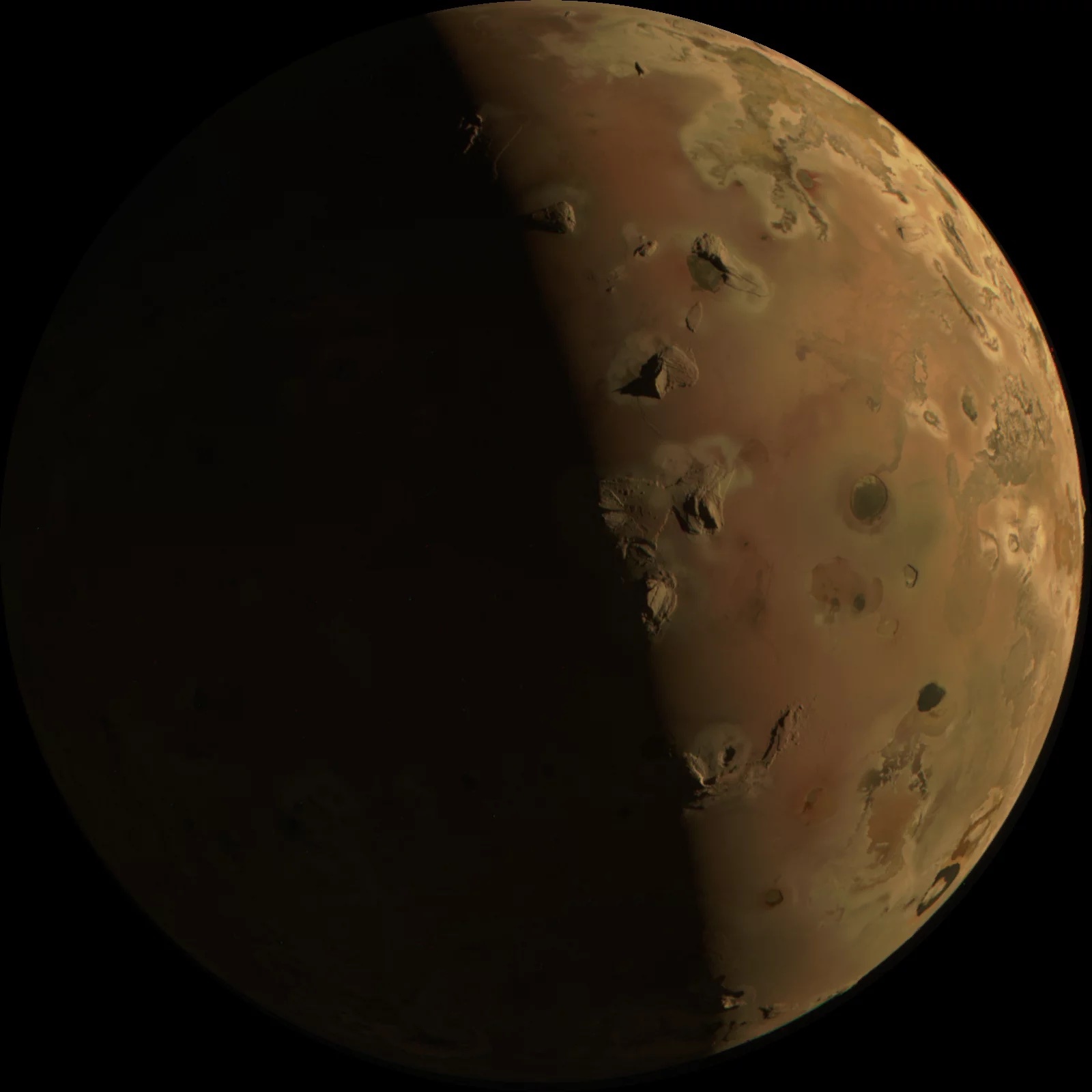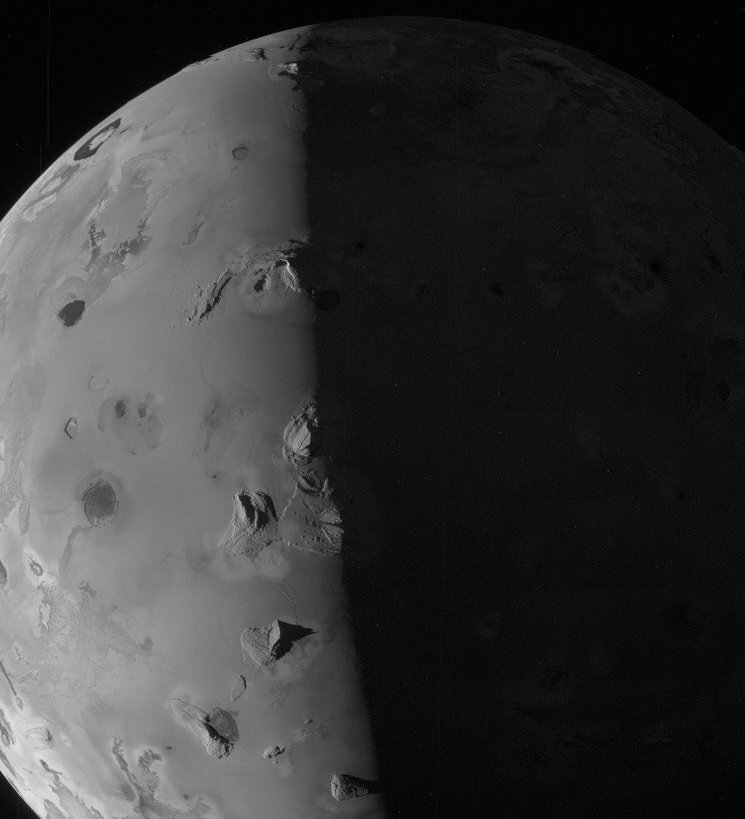1.11.2023
Salts and Organics Observed on Ganymede’s Surface by NASA’s Juno
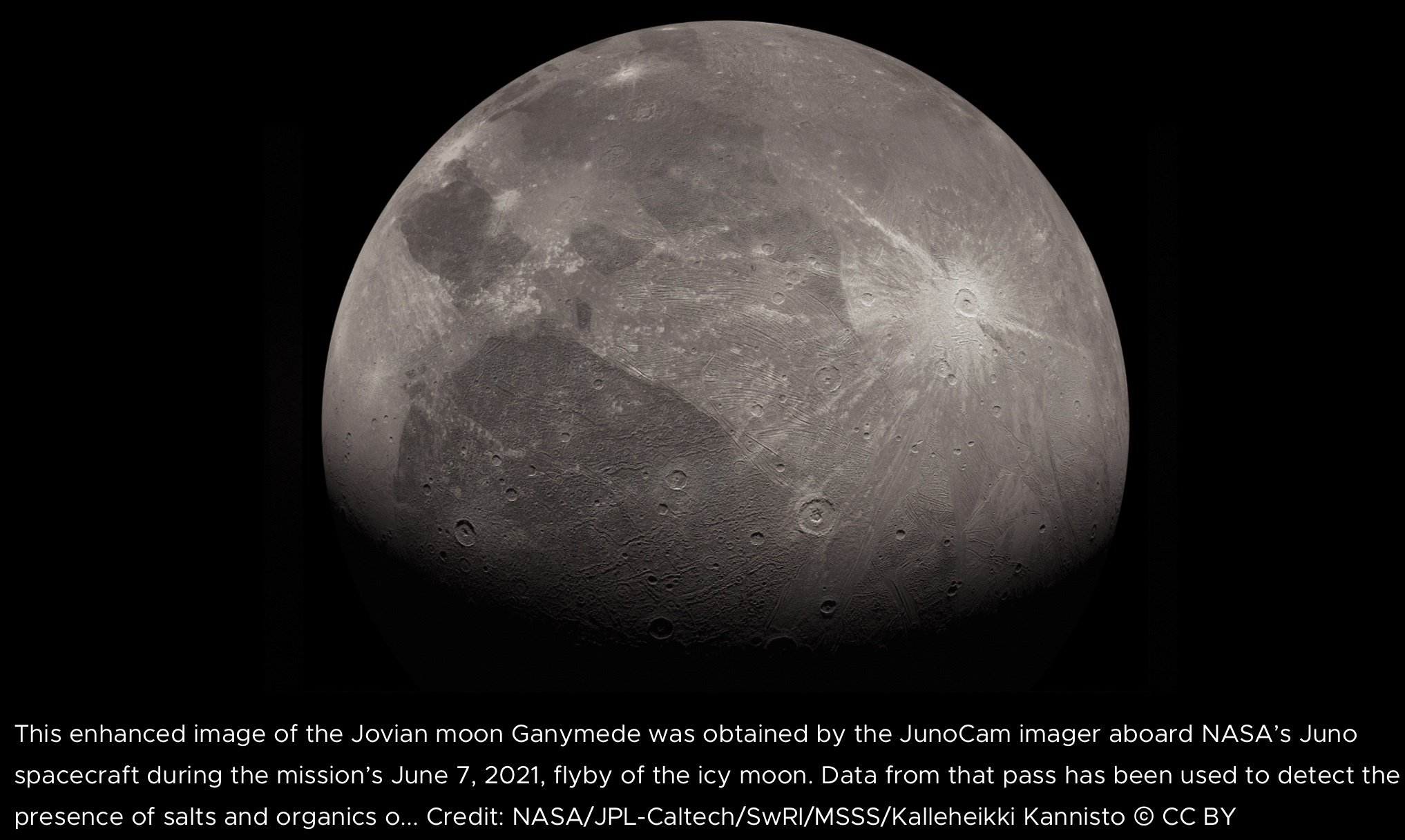
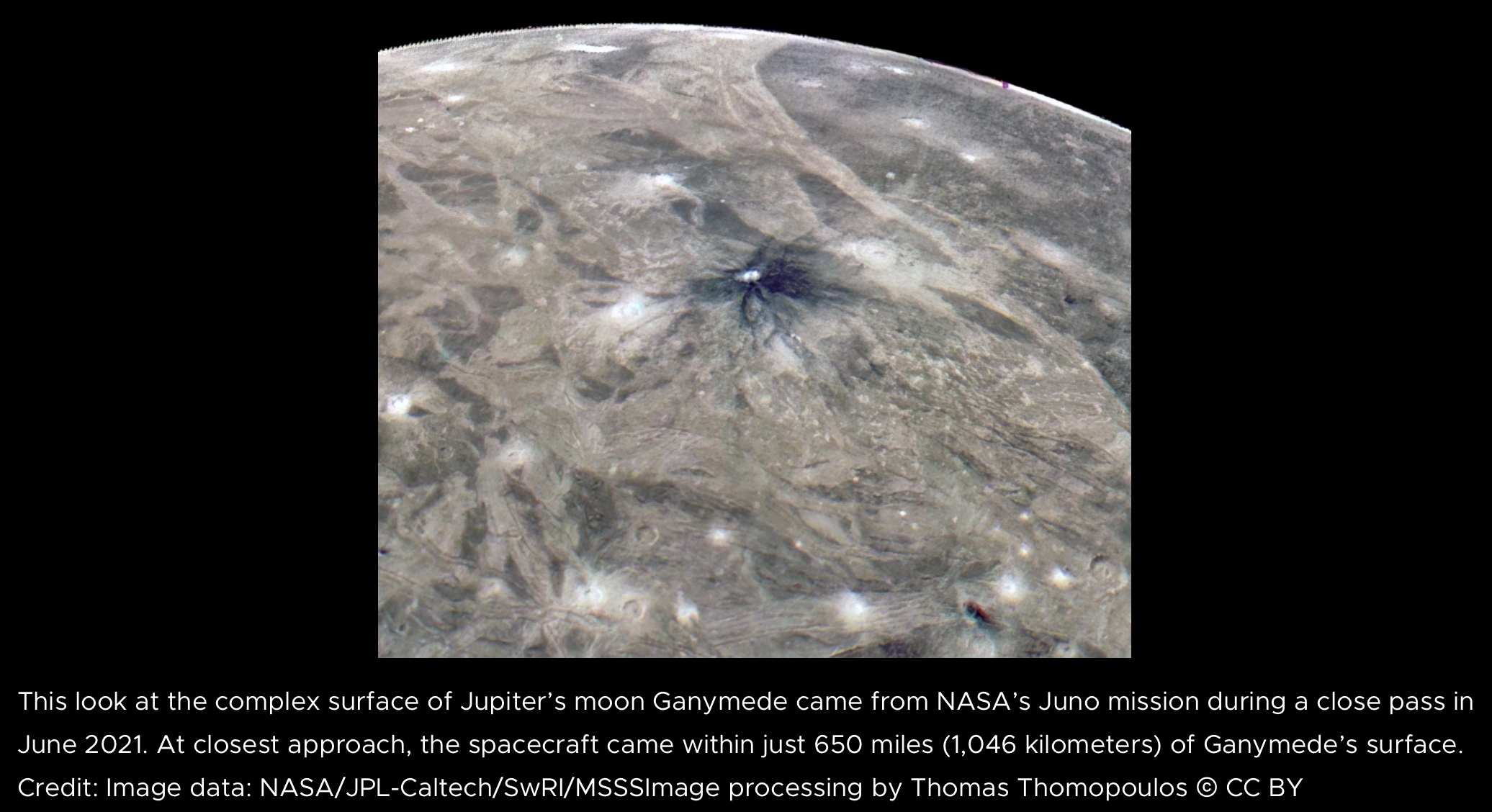
Data collected by NASA’s Juno mission indicates a briny past may be bubbling to the surface on Jupiter’s largest moon.
NASA’s Juno mission has observed mineral salts and organic compounds on the surface of Jupiter’s moon Ganymede. Data for this discovery was collected by the Jovian InfraRed Auroral Mapper (JIRAM) spectrometer aboard the spacecraft during a close flyby of the icy moon. The findings, which could help scientists better understand the origin of Ganymede and the composition of its deep ocean, were published on Oct. 30 in the journal Nature Astronomy.
Larger than the planet Mercury, Ganymede is the biggest of Jupiter’s moons and has long been of great interest to scientists due to the vast internal ocean of water hidden beneath its icy crust. Previous spectroscopic observations by NASA’s Galileospacecraft and Hubble Space Telescope as well as the European Southern Observatory’s Very Large Telescope hinted at the presence of salts and organics, but the spatial resolution of those observations was too low to make a determination.
On June 7, 2021, Juno flew over Ganymede at a minimum altitude of 650 miles (1,046 kilometers). Shortly after the time of closest approach, the JIRAM instrument acquired infrared images and infrared spectra (essentially the chemical fingerprints of materials, based on how they reflect light) of the moon’s surface. Built by the Italian Space Agency, Agenzia Spaziale Italiana, JIRAM was designed to capture the infrared light (invisible to the naked eye) that emerges from deep inside Jupiter, probing the weather layer down to 30 to 45 miles (50 to 70 kilometers) below the gas giant’s cloud tops. But the instrument has also been used to offer insights into the terrain of moons Io, Europa, Ganymede, and Callisto (known collectively as the Galilean moons for their discoverer, Galileo).
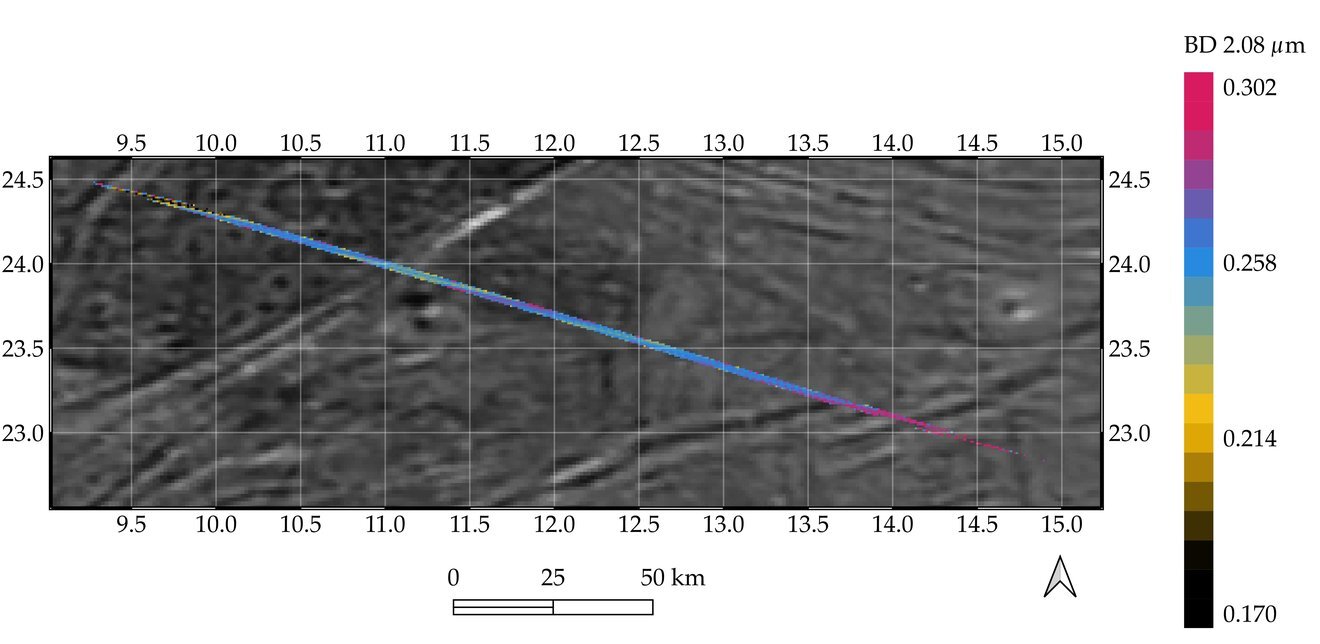
Processed data from the Jovian InfraRed Auroral Mapper (JIRAM) spectrometer aboard NASA’s Juno mission is superimposed on a mosaic of optical images from the agency’s Galileo and Voyager spacecraft that show grooved terrain on Jupiter’s moon Ganymede.
Credit: NASA/JPL-Caltech/SwRI/ASI/INAF/JIRAM/Brown University
The JIRAM data of Ganymede obtained during the flyby achieved an unprecedented spatial resolution for infrared spectroscopy – better than 0.62 miles (1 kilometer) per pixel. With it, Juno scientists were able to detect and analyze the unique spectral features of non-water-ice materials, including hydrated sodium chloride, ammonium chloride, sodium bicarbonate, and possibly aliphatic aldehydes.
“The presence of ammoniated salts suggests that Ganymede may have accumulated materials cold enough to condense ammonia during its formation,” said Federico Tosi, a Juno co-investigator from Italy’s National Institute for Astrophysics in Rome and lead author of the paper. “The carbonate salts could be remnants of carbon dioxide-rich ices.”
Exploring Other Jovian Worlds
Previous modeling of Ganymede’s magnetic field determined the moon’s equatorial region, up to a latitude of about 40 degrees, is shielded from the energetic electron and heavy ion bombardment created by Jupiter’s hellish magnetic field. The presence of such particle fluxes is well known to negatively impact salts and organics.
During the June 2021 flyby, JIRAM covered a narrow range of latitudes (10 degrees north to 30 degrees north) and a broader range of longitudes (minus 35 degrees east to 40 degrees east) in the Jupiter-facing hemisphere.
“We found the greatest abundance of salts and organics in the dark and bright terrains at latitudes protected by the magnetic field,” said Scott Bolton, Juno’s principal investigator from the Southwest Research Institute in San Antonio. “This suggests we are seeing the remnants of a deep ocean brine that reached the surface of this frozen world.”
Ganymede is not the only Jovian world Juno has flown by. The moon Europa, thought to harbor an ocean under its icy crust, also came under Juno’s gaze, first in October 2021 and then in September 2022. Now Io is receiving the flyby treatment. The next close approach to that volcano-festooned world is scheduled for Dec. 30, when the spacecraft will come within 932 miles (1,500 kilometers) of Io’s surface.
More About the Mission
NASA’s Jet Propulsion Laboratory, a division of Caltech in Pasadena, California, manages the Juno mission for the principal investigator, Scott Bolton, of the Southwest Research Institute in San Antonio. Juno is part of NASA’s New Frontiers Program, which is managed at NASA’s Marshall Space Flight Center in Huntsville, Alabama, for the agency’s Science Mission Directorate in Washington. The Italian Space Agency (ASI) funded the Jovian InfraRed Auroral Mapper. Lockheed Martin Space in Denver built and operates the spacecraft.
Quelle: NASA
----
Update: 11.11.2023
.
NASA’s Juno Finds Jupiter’s Winds Penetrate in Cylindrical Layers
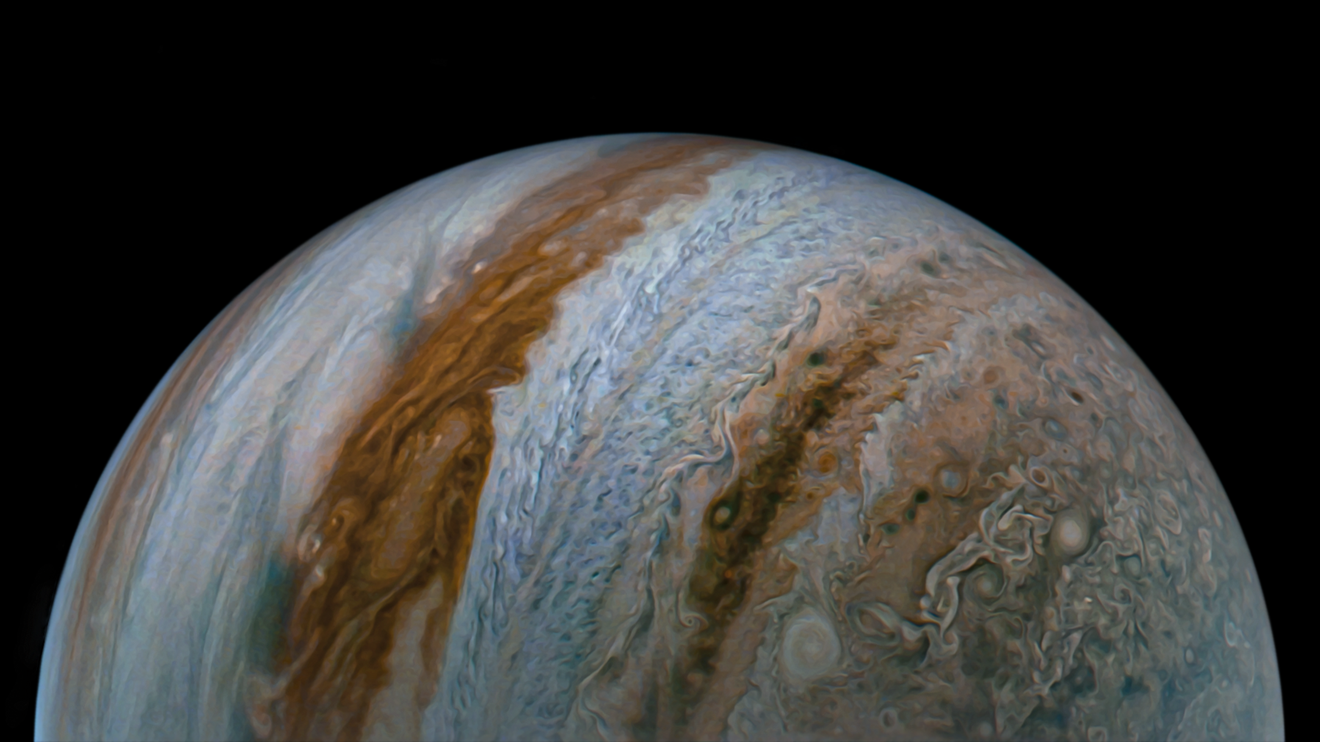
NASA’s Juno captured this view of Jupiter during the mission’s 54th close flyby of the giant planet on Sept. 7. The image was made with raw data from the JunoCam instrument that was processed to enhance details in cloud features and colors.
Credit: Image data: NASA/JPL-Caltech/SwRI/MSSS Image processing by Tanya Oleksuik CC BY NC SA 3.0
The finding offers deeper insights into the long-debated internal structure of the gas giant.
Gravity data collected by NASA’s Juno mission indicates Jupiter’s atmospheric winds penetrate the planet in a cylindrical manner, parallel to its spin axis. A paper on the findings was recently published in the journal Nature Astronomy.
The violent nature of Jupiter’s roiling atmosphere has long been a source of fascination for astronomers and planetary scientists, and Juno has had a ringside seat to the goings-on since it entered orbit in 2016. During each of the spacecraft’s 55 to date, a suite of science instruments has peered below Jupiter’s turbulent cloud deck to uncover how the gas giant works from the inside out.
One way the Juno mission learns about the planet’s interior is via radio science. Using NASA’s Deep Space Network antennas, scientists track the spacecraft’s radio signal as Juno flies past Jupiter at speeds near 130,000 mph (209,000 kph), measuring tiny changes in its velocity – as small as 0.01 millimeter per second. Those changes are caused by variations in the planet’s gravity field, and by measuring them, the mission can essentially see into Jupiter’s atmosphere.
Such measurements have led to numerous discoveries, including the existence of a dilute core deep within Jupiter and the depth of the planet’s zones and belts, which extend from the cloud tops down approximately 1,860 miles (3,000 kilometers).
Doing the Math
To determine the location and cylindrical nature of the winds, the study’s authors applied a mathematical technique that models gravitational variations and surface elevations of rocky planets like Earth. At Jupiter, the technique can be used to accurately map winds at depth. Using the high-precision Juno data, the authors were able to generate a four-fold increase in the resolution over previous models created with data from NASA’s trailblazing Jovian explorers Voyager and Galileo.
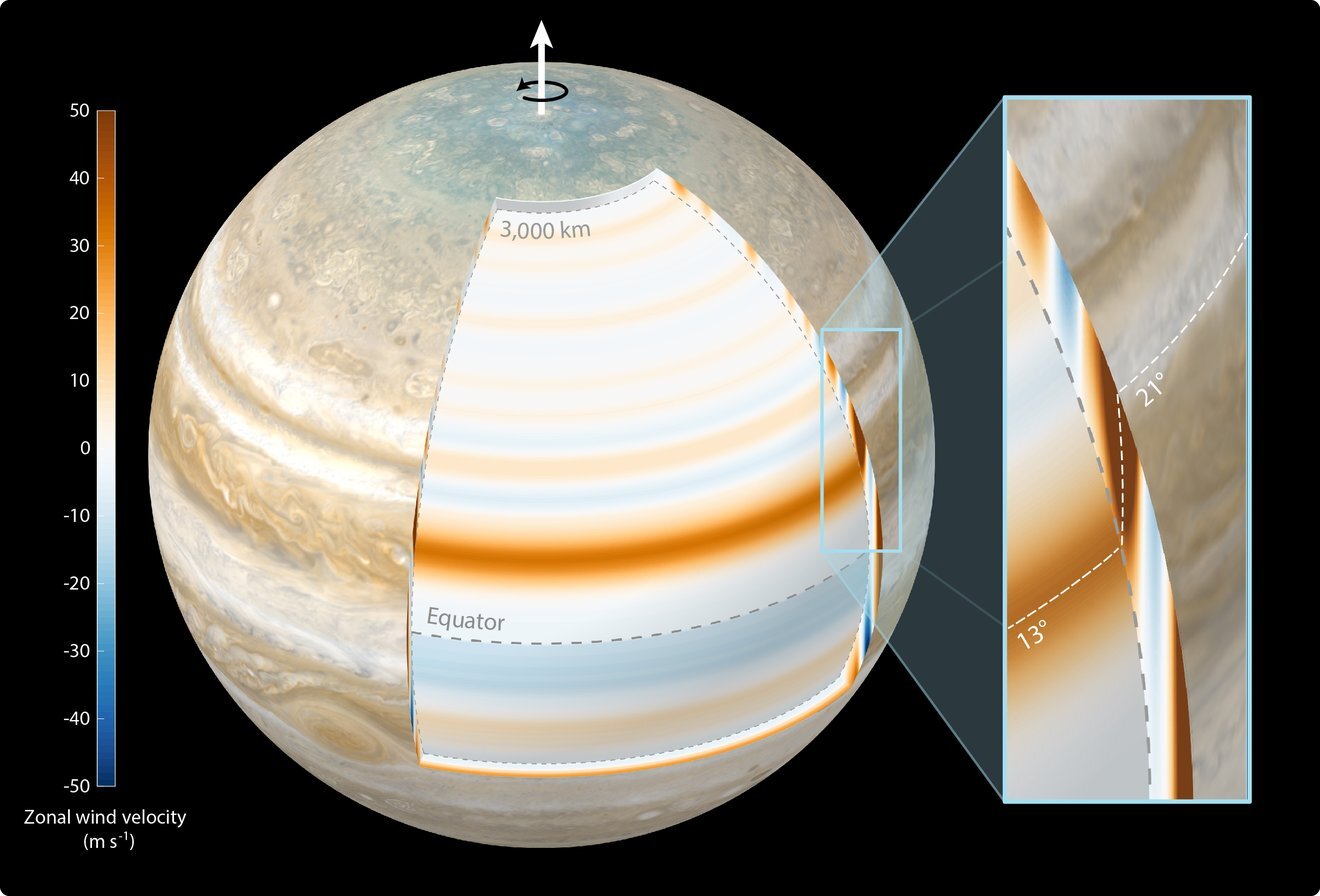
This illustration depicts findings that Jupiter’s atmospheric winds penetrate the planet in a cylindrical manner and parallel to its spin axis. The most dominant jet recorded by NASA’s Juno is shown in the cutout: The jet is at 21 degrees north latitude at cloud level, but 1,800 miles (3,000 kilometers) below that, it’s at 13 degrees north latitude.
Credit: NASA/JPL-Caltech/SSI/SWRI/MSSS/ASI/ INAF/JIRAM/Björn Jónsson CC BY 3.0
“We applied a constraining technique developed for sparse data sets on terrestrial planets to process the Juno data,” said Ryan Park, a Juno scientist and lead of the mission’s gravity science investigation from NASA’s Jet Propulsion Laboratory in Southern California. “This is the first time such a technique has been applied to an outer planet.”
The measurements of the gravity field matched a two-decade-old model that determined Jupiter’s powerful east-west zonal flows extend from the cloud-level white and red zones and belts inward. But the measurements also revealed that rather than extending in every direction like a radiating sphere, the zonal flows go inward, cylindrically, and are oriented along the direction of Jupiter’s rotation axis. How Jupiter’s deep atmospheric winds are structured has been in debated since the 1970s, and the Juno mission has now settled the debate.
“All 40 gravity coefficients measured by Juno matched our previous calculations of what we expect the gravity field to be if the winds penetrate inward on cylinders,” said Yohai Kaspi of the Weizmann Institute of Science in Israel, the study’s lead author and a Juno co-investigator. “When we realized all 40 numbers exactly match our calculations, it felt like winning the lottery.”
Along with bettering the current understanding of Jupiter’s internal structure and origin, the new gravity model application could be used to gain more insight into other planetary atmospheres.
Juno is currently in an extended mission. Along with flybys of Jupiter, the solar-powered spacecraft has completed a series of flybys of the planet’s icy moons Ganymede and Europa and is in the midst of several close flybys of Io. The Dec. 30 flyby of Io will be the closest to date, coming within about 930 miles (1,500 kilometers) of its volcano-festooned surface.
“As Juno’s journey progresses, we’re achieving scientific outcomes that truly define a new Jupiter and that likely are relevant for all giant planets, both within our solar system and beyond,” said Scott Bolton, the principal investigator of the Juno mission at the Southwest Research Institute in San Antonio. “The resolution of the newly determined gravity field is remarkably similar to the accuracy we estimated 20 years ago. It is great to see such agreement between our prediction and our results.”
Quelle: NASA
----
Update: 29.12.2023
.
NASA’s Juno to Get Close Look at Jupiter’s Volcanic Moon Io on Dec. 30
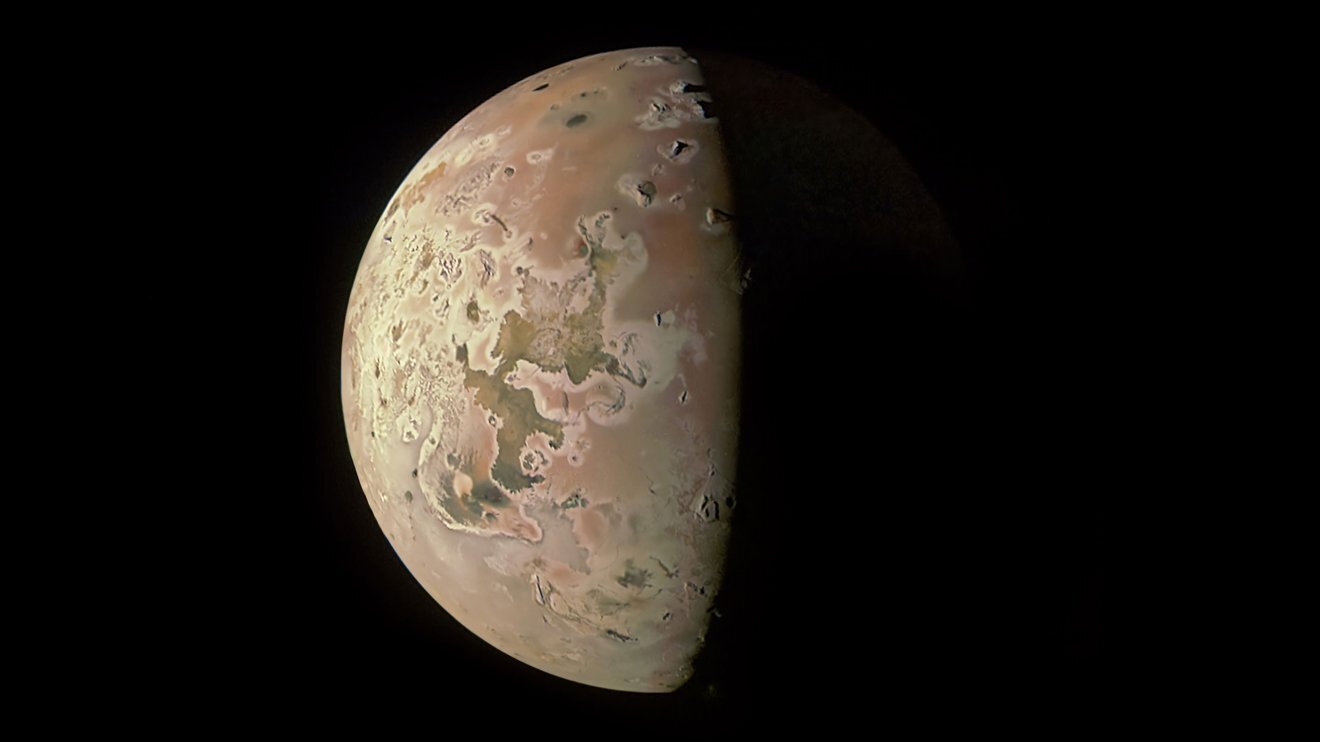
This image revealing the north polar region of the Jovian moon Io was taken on October 15 by NASA’s Juno. Three of the mountain peaks visible in the upper part of image, near the day-night dividing line, were observed here for the first time by the spacecraft’s JunoCam.
Credit: Image data: NASA/JPL-Caltech/SwRI/MSSS, Image processing by Ted Stryk
The orbiter has performed 56 flybys of Jupiter and documented close encounters with three of the gas giant’s four largest moons.
NASA’s Juno spacecraft will on Saturday, Dec. 30, make the closest flyby of Jupiter’s moon Io that any spacecraft has made in over 20 years. Coming within roughly 930 miles (1,500 kilometers) from the surface of the most volcanic world in our solar system, the pass is expected to allow Juno instruments to generate a firehose of data.
“By combining data from this flyby with our previous observations, the Juno science team is studying how Io’s volcanoes vary,” said Juno’s principal investigator, Scott Bolton of the Southwest Research Institute in San Antonio, Texas. “We are looking for how often they erupt, how bright and hot they are, how the shape of the lava flow changes, and how Io’s activity is connected to the flow of charged particles in Jupiter’s magnetosphere.”
A second ultra-close flyby of Io is scheduled for Feb. 3, 2024, in which Juno will again come within about 930 miles (1,500 kilometers) of the surface.
The spacecraft has been monitoring Io’s volcanic activity from distances ranging from about 6,830 miles (11,000 kilometers) to over 62,100 miles (100,000 kilometers), and has provided the first views of the moon’s north and south poles. The spacecraft has also performed close flybys of Jupiter’s icy moons Ganymede and Europa.
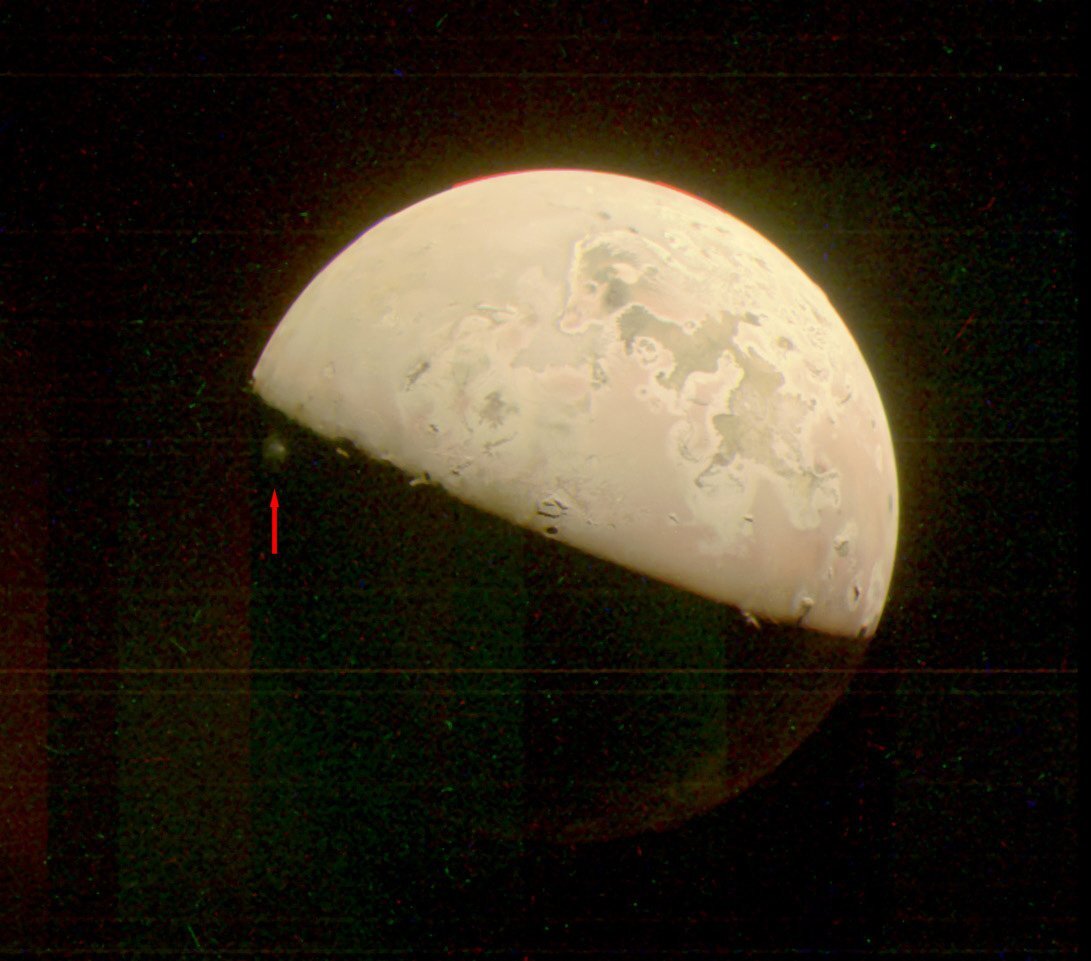
This JunoCam image of Jupiter’s moon Io captures a plume of material ejected from the (unseen) volcano Prometheus. Indicated by the red arrow, the plume is just visible in the darkness below the terminator (the line dividing day and night). The image was taken by NASA’s Juno spacecraft on October 15. Credit: NASA/JPL-Caltech/SwRI/MSSS
“With our pair of close flybys in December and February, Juno will investigate the source of Io’s massive volcanic activity, whether a magma ocean exists underneath its crust, and the importance of tidal forces from Jupiter, which are relentlessly squeezing this tortured moon,” said Bolton.
Now in the third year of its extended mission to investigate the origin of Jupiter, the solar-powered spacecraft will also explore the ring system where some of the gas giant’s inner moons reside.
Picture This
All three cameras aboard Juno will be active during the Io flyby. The Jovian Infrared Auroral Mapper (JIRAM), which takes images in infrared, will be collecting the heat signatures emitted by volcanoes and calderas covering the moon’s surface. The mission’s Stellar Reference Unit (a navigational star camera that has also provided valuable science) will obtain the highest-resolution image of the surface to date. And the JunoCam imager will take visible-light color images.
JunoCam was included on the spacecraft for the public’s engagement and was designed to operate for up to eight flybys of Jupiter. The upcoming flyby of Io will be Juno’s 57th orbit around Jupiter, where the spacecraft and cameras have endured one of the solar system’s most punishing radiation environments.
“The cumulative effects of all that radiation has begun to show on JunoCam over the last few orbits,” said Ed Hirst, project manager of Juno at NASA’s Jet Propulsion Laboratory in Southern California. “Pictures from the last flyby show a reduction in the imager’s dynamic range and the appearance of ‘striping’ noise. Our engineering team has been working on solutions to alleviate the radiation damage and to keep the imager going.”
More Io, Please
After several months of study and assessment, the Juno team adjusted the spacecraft’s planned future trajectory to add seven new distant Io flybys (for a total of 18) to the extended mission plan. After the close Io pass on Feb. 3, the spacecraft will fly by Io every other orbit, with each orbit growing progressively more distant: The first will be at an altitude of about 10,250 miles (16,500 kilometers) above Io, and the last will be at about 71,450 miles (115,000 kilometers).
The gravitational pull of Io on Juno during the Dec. 30 flyby will reduce the spacecraft’s orbit around Jupiter from 38 days to 35 days. Juno’s orbit will drop to 33 days after the Feb. 3 flyby.
After that, Juno’s new trajectory will result in Jupiter blocking the Sun from the spacecraft for about five minutes at the time when the orbiter is at its closest to the planet, a period called perijove. Although this will be the first time the solar-powered spacecraft has encountered darkness since its flyby of Earth in October 2013, the duration will be too short to affect its overall operation. With the exception of the Feb. 3 perijove, the spacecraft will encounter solar eclipses like this during every close flyby of Jupiter from now on through the remainder of its extended mission, which ends in late 2025.
Starting in April 2024, the spacecraft will carry out a series of occultation experiments that use Juno’s Gravity Science experiment to probe Jupiter’s upper atmospheric makeup, which provides key information on the planet’s shape and interior structure.
Quelle: NASA
----
Update: 31.12.2023
.


